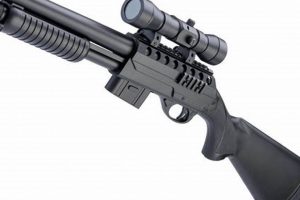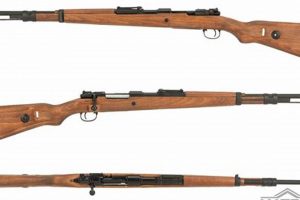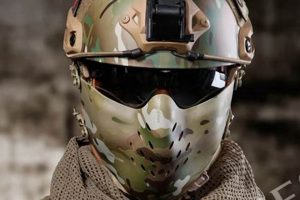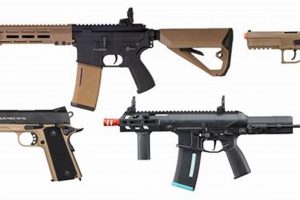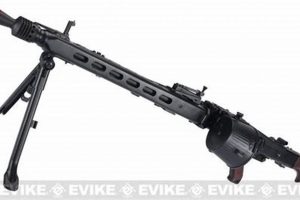Protective gear designed for the lower abdominal and pelvic regions during airsoft gameplay is crucial for mitigating potential injury. This specialized equipment shields players from impacts caused by projectiles in a vulnerable area, providing a layer of defense against direct hits. Typically constructed from durable materials like hard plastics or reinforced fabrics, these safeguards are integrated into or worn beneath standard tactical attire.
The value of safeguarding this region extends beyond mere comfort. Blunt force trauma in this area can lead to temporary or, in rare instances, more severe health concerns. Employing such protection allows players to participate more confidently and aggressively, knowing they have significantly reduced their risk of harm. Historically, the need for such protective measures has grown alongside the increasing popularity and intensity of airsoft as a recreational activity.
With the fundamental understanding of this essential equipment established, the subsequent sections will delve into specific product types, material considerations, fitting guidelines, and crucial maintenance procedures for ensuring the longevity and effectiveness of these vital protective elements.
Essential Usage and Maintenance Guidelines
Proper utilization and upkeep are vital for maximizing the protective capabilities and lifespan of this equipment. The following guidelines outline critical steps to ensure effective defense and durability.
Tip 1: Prioritize Proper Fit: Ill-fitting protective gear can shift during activity, leaving vulnerable areas exposed. Ensure a snug, yet comfortable fit that allows for a full range of motion without compromising coverage. Adjustment straps and sizing charts should be consulted meticulously prior to use.
Tip 2: Inspect Before Each Use: Thoroughly examine the protector for cracks, tears, or weakened seams. Any compromise in structural integrity can significantly reduce its protective effectiveness. Discontinue use and replace the equipment if any damage is detected.
Tip 3: Clean Regularly: Sweat and debris can degrade the materials over time. Regularly clean the protector according to the manufacturer’s instructions. Mild soap and water are generally suitable, but avoid harsh chemicals that can damage the fabric or plastic components.
Tip 4: Store Properly: When not in use, store the gear in a cool, dry place away from direct sunlight. Prolonged exposure to extreme temperatures or UV radiation can weaken the materials and shorten its lifespan.
Tip 5: Consider Layering: Depending on the specific design, consider wearing additional layers of protective clothing underneath. This can provide enhanced cushioning and further mitigate the impact of projectiles.
Tip 6: Replace as Needed: Even with diligent care, protective equipment degrades over time. Be prepared to replace the protector periodically, especially after significant impacts or signs of wear and tear. The manufacturer’s recommendations regarding lifespan should be consulted.
Tip 7: Adhere to Field Regulations: Specific airsoft fields may have regulations regarding the type or level of protective gear required. Always familiarize oneself with and adhere to these rules to ensure compliance and safety.
By consistently implementing these guidelines, players can significantly enhance their safety and prolong the usability of their protective equipment. These practices are crucial for responsible and secure participation in airsoft activities.
With these essential tips covered, the following section will explore different types of materials used in the construction of this equipment and their respective benefits.
1. Impact Resistance Materials
Impact resistance materials are paramount in the context of equipment designed to safeguard the lower abdominal and pelvic regions during airsoft activities. The selection and performance of these materials directly correlate with the level of protection offered against the kinetic energy of projectiles.
- Polymer Composition and Density
The type and density of polymers used significantly influence the impact absorption capacity. High-density polyethylene (HDPE) and polypropylene (PP) are common choices, offering a balance of durability and cost-effectiveness. Higher densities generally translate to greater resistance to penetration and deformation upon impact.
- Reinforcement Techniques
Reinforcing materials, such as ballistic nylon or composite laminates, can be integrated to enhance the structural integrity. These additions distribute impact forces across a larger surface area, mitigating localized stress and reducing the risk of failure. Kevlar and carbon fiber offer exceptional strength-to-weight ratios, but may increase the cost.
- Energy Absorption Characteristics
Materials exhibiting high energy absorption are preferred, converting kinetic energy into other forms, such as heat or deformation, rather than transmitting it to the user. Expanded polystyrene (EPS) and specialized foams are utilized for their ability to compress under impact, dissipating energy and minimizing blunt force trauma.
- Material Thickness and Layering
The thickness of the material and the number of layers employed directly impact the protective capabilities. Thicker materials provide greater resistance to penetration, while multiple layers can offer enhanced energy absorption and impact distribution. The layering approach allows for combining materials with different properties to optimize overall performance.
In summary, the selection of appropriate impact resistance materials is fundamental to the effectiveness. The interplay between polymer composition, reinforcement techniques, energy absorption characteristics, and design considerations like thickness and layering determines the degree of protection afforded to the wearer. Continuous advancements in material science are driving the development of lighter, stronger, and more effective protective solutions in airsoft and beyond.
2. Ergonomic Design Standards
Ergonomic design standards play a critical role in the effectiveness and usability of protective equipment used in airsoft, specifically concerning groin protectors. These standards emphasize the optimization of the interaction between the user and the equipment to enhance comfort, mobility, and protective capability.
- Range of Motion Optimization
Ergonomic design directly impacts a user’s range of motion. A well-designed protector allows for unrestricted movement crucial for airsoft gameplay, including running, crouching, and maneuvering in diverse terrains. Poorly designed equipment can impede these movements, reducing player effectiveness and potentially increasing the risk of injury due to impaired agility. Designs incorporate articulated joints or flexible materials to maintain protection without hindering mobility.
- Weight Distribution and Balance
Proper weight distribution is essential for comfort and endurance during extended periods of use. Ergonomic designs distribute weight evenly across the protected area, minimizing strain and preventing discomfort. An unbalanced protector can lead to fatigue and decreased performance. Lightweight materials and strategic placement of protective elements contribute to optimal weight distribution.
- Ventilation and Breathability
Ventilation is vital to mitigate heat buildup and moisture accumulation within the protector. Ergonomic designs often incorporate ventilation channels or breathable materials to improve airflow and reduce discomfort. Excessive heat and moisture can lead to skin irritation and reduced concentration, impacting player performance. Ventilation designs must balance airflow with maintaining adequate protection.
- Conformity to Anatomical Contours
Anatomically correct designs ensure a secure and comfortable fit. Contoured shapes and adjustable straps allow the protector to conform to the user’s body, minimizing gaps and maximizing protection. Ill-fitting equipment can shift during activity, exposing vulnerable areas and reducing the effectiveness of the protective gear. Measurements, sizing charts, and adjustable features are critical components of ergonomically sound designs.
These considerations collectively contribute to the overall effectiveness. Ergonomic design, encompassing range of motion, weight distribution, ventilation, and anatomical conformity, determines the comfort, usability, and protective capability. Prioritizing these design principles ensures that the protective equipment seamlessly integrates with the user’s movements and activities, ultimately enhancing safety and performance in airsoft.
3. Secure Attachment Methods
Secure attachment methods constitute a foundational element of effective protection during airsoft activities, particularly for equipment safeguarding the lower abdominal and pelvic regions. The reliability of these attachment mechanisms directly impacts the ability of the protective gear to maintain its intended position during dynamic movements and potential impacts. Failure of the attachment system compromises the protective coverage, rendering the equipment ineffective and increasing the risk of injury. For instance, inadequate straps or flimsy buckles can cause the protector to shift or detach entirely upon impact from a projectile, leaving the targeted area exposed.
Variations in attachment systems include adjustable straps with robust buckles, integrated belt loops for compatibility with tactical belts, and hook-and-loop fasteners designed for rapid attachment and detachment. The selection of the most suitable method depends on factors such as the overall design of the protector, the intended use case, and the player’s personal preferences. A well-engineered attachment system not only ensures secure positioning but also allows for a customized fit, maximizing comfort and minimizing restriction of movement. Rigorous testing of these attachment mechanisms is critical to verify their durability and resistance to failure under simulated combat conditions.
In summary, secure attachment methods are non-negotiable for reliable protection. The effectiveness of protective gear hinges on its ability to remain firmly in place during strenuous activity and impact. A properly designed and tested attachment system contributes directly to player safety and confidence on the airsoft field. Compromises in attachment security can have serious repercussions, negating the benefits of the protector’s other features. Therefore, careful consideration of attachment methods is essential when selecting protective equipment.
4. Adjustability Considerations
Adjustability considerations are integral to the effectiveness and comfort of equipment designed to protect the lower abdominal and pelvic regions during airsoft activities. A rigid, ill-fitting protector can impede mobility, reduce player effectiveness, and potentially increase the risk of injury due to restricted movement. Therefore, adjustability mechanisms are engineered to accommodate variations in body size and shape, ensuring a secure and customized fit.
- Waist and Leg Strap Adjustments
Adjustable straps, typically incorporating buckles or hook-and-loop fasteners, allow users to tailor the fit around the waist and legs. These adjustments accommodate differences in waist circumference and leg size, ensuring a snug and secure fit that prevents shifting during dynamic movements. Insufficient strap adjustability can result in a protector that rides up or slides down, exposing vulnerable areas to potential impacts. Conversely, overly tight straps can restrict blood flow and cause discomfort during prolonged use. The range and ease of adjustment are critical factors in evaluating the suitability of a particular model.
- Vertical Height Adjustment
Some protectors incorporate vertical height adjustment mechanisms, enabling users to modify the vertical positioning of the protective element. This is particularly important for accommodating differences in torso length and ensuring optimal coverage of the lower abdomen and groin area. Insufficient height adjustment can result in either inadequate coverage or interference with other equipment, such as tactical belts or plate carriers. Mechanisms may include sliding panels or adjustable webbing systems. The presence and effectiveness of height adjustment features contribute significantly to the overall level of customization and protection offered.
- Padding Thickness and Placement
While not strictly an “adjustment” in the mechanical sense, the strategic placement and thickness of internal padding contribute to the overall comfort and fit. Padding provides cushioning against impacts and helps to conform the protector to the wearer’s body. Some models offer removable or adjustable padding to further customize the fit and accommodate individual preferences. The quality and density of the padding materials influence both comfort and protective performance.
- Integration with Tactical Gear
Adjustability extends to how well the protector integrates with other tactical gear, such as belts or MOLLE systems. Some protectors are designed to be worn independently, while others are intended to be integrated into existing load-bearing systems. Adjustable attachment points or compatibility features allow users to customize the integration of the protector into their overall equipment setup. Compatibility and adjustability in this context ensure that the protector does not interfere with the function of other gear and that the entire system works harmoniously.
In summary, adjustability considerations are fundamental to the efficacy of a protective device. The combination of adjustable straps, vertical height modifications, strategic padding, and compatibility with other gear collectively determine the overall fit, comfort, and protective capability. Neglecting these aspects can lead to compromised protection and reduced player performance. A focus on comprehensive adjustability features is essential for maximizing the benefits of specialized equipment.
5. Consistent Protective Coverage
Consistent protective coverage constitutes a non-negotiable requirement for any device intended to safeguard the lower abdominal and pelvic regions in the context of airsoft. The efficacy of such equipment hinges on its ability to provide uninterrupted protection across the entire target area, effectively mitigating the risk of injury from projectile impacts. Gaps or inconsistencies in the coverage can render the protective gear largely ineffective, as even small exposed areas become vulnerable to potentially harmful strikes. This principle underscores the critical importance of a design that prioritizes complete and reliable protection across the entire intended coverage area. Real-world examples illustrate the potential consequences of inconsistent protection; instances have been documented where individuals sustained injuries due to projectiles penetrating unprotected gaps or weak points in the equipment. This highlights the practical significance of understanding the role of consistent protective coverage in the overall functionality and safety of protective gear.
The design and manufacturing processes must incorporate rigorous quality control measures to ensure consistent protective coverage. These measures include careful attention to material selection, construction techniques, and attachment mechanisms. For example, overlapping layers of protective material may be employed to eliminate gaps and ensure continuous protection, even during dynamic movements. Adjustable straps and secure attachment points are essential for maintaining the correct positioning of the equipment, preventing it from shifting or rotating and exposing vulnerable areas. Furthermore, testing protocols should simulate real-world scenarios to evaluate the performance of the protective gear under various conditions, including impacts from different angles and intensities. These tests help identify any weaknesses or inconsistencies in the protective coverage, allowing for design modifications and quality improvements.
In conclusion, consistent protective coverage is paramount for mitigating the risks associated with airsoft activities. The absence of such coverage can have serious consequences, underscoring the need for rigorous design, manufacturing, and testing processes to ensure complete and reliable protection. While challenges exist in achieving perfect coverage in all scenarios, a commitment to this principle is essential for safeguarding the well-being of airsoft participants. This understanding links directly to the broader theme of responsible gameplay and the importance of prioritizing safety in all aspects of the sport.
Frequently Asked Questions
The following addresses common inquiries regarding protective equipment for the lower abdominal and pelvic regions in airsoft, providing clarity on usage, safety, and maintenance.
Question 1: What specific types of injuries does this equipment aim to prevent?
This equipment primarily mitigates blunt force trauma from direct projectile impacts. Potential injuries include contusions, hematomas, and, in rare cases, damage to internal organs in the lower abdominal and pelvic areas.
Question 2: How should the correct size be determined to ensure optimal protection?
Measurements should be taken around the waist and upper thighs, consulting the manufacturer’s sizing chart for precise guidance. A snug, yet comfortable fit that allows for a full range of motion is ideal, ensuring consistent coverage without restricting movement.
Question 3: What are the primary materials used in the construction of these protective devices?
Common materials include high-density polyethylene (HDPE), polypropylene (PP), ballistic nylon, and reinforced composite laminates. The selection depends on the desired balance between impact resistance, weight, and cost.
Question 4: How often should this equipment be inspected for signs of wear and tear?
A thorough inspection should be conducted before each use. Examine for cracks, tears, weakened seams, or compromised attachment mechanisms. Discontinue use and replace the equipment if any damage is detected.
Question 5: What cleaning procedures are recommended to maintain the integrity of the protective materials?
Regular cleaning with mild soap and water is generally suitable. Harsh chemicals should be avoided as they can degrade the fabric or plastic components. Always follow the manufacturer’s specific cleaning instructions.
Question 6: Are there specific regulations regarding the use of this equipment on organized airsoft fields?
Field regulations vary. It is imperative to familiarize oneself with and adhere to the rules of the specific airsoft field regarding the type or level of protective gear required. Compliance ensures safety and responsible participation.
These FAQs provide essential information regarding the proper utilization and maintenance of protective equipment. Consistent adherence to these guidelines enhances safety and extends the lifespan of the gear.
The subsequent section will delve into a comparative analysis of different product types and their respective performance characteristics.
Conclusion
The preceding exploration has detailed the crucial role of the “airsoft groin protector” in mitigating potential injuries during gameplay. Key points include material composition, ergonomic design, secure attachment, adjustability, and consistent protective coverage. Each element contributes to the overall effectiveness of this essential piece of equipment.
Ultimately, informed selection and diligent maintenance of the “airsoft groin protector” are paramount for responsible participation in airsoft activities. Prioritizing safety through adherence to established guidelines and a commitment to using appropriately rated equipment remains fundamental for minimizing risk and ensuring a more secure gaming experience.


